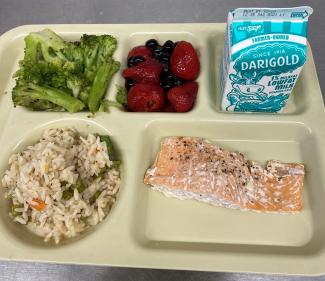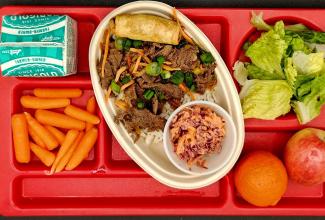Media Contact
Katy Payne she/her
360-764-0201
From cherries grown in eastern Washington to salmon caught west of the Cascades, local foods are on the menu for public school students across the state.
The Local Food for Schools Cooperative Agreement Program (LFS), a U.S. Department of Agriculture (USDA) grant program, makes fresh, local foods available for school meals by connecting schools to local farmers, ranchers, fishers, and producers. Their products have been served to nearly 850,000 Washington students in 204 school districts across the state this year.

“When our students get nutritious local foods in their school meals, they’re learning healthy eating habits at the same time that they’re learning about the food chain, the environmental needs of different plants, and the bounty of food products that come from our state,” said State Superintendent Chris Reykdal. “The LFS program helps students engage more deeply with their communities and boosts economic opportunities for local producers across Washington. I’m proud to be part of these efforts, and I’m thankful for the opportunity provided by the USDA.”
The Office of Superintendent of Public Instruction (OSPI) was awarded $3.6 million through the LFS program to purchase local and regional foods, including blackberries, cherries, crimson and green lentils, Coho salmon, and ground bison. These foods are provided at no cost to schools participating in the National School Lunch Program (NSLP).
Washington’s public schools have been incorporating local foods into their menus throughout the 2023–24 school year. Some examples include:
- Boistfort School District: Located approximately 40 miles south of Olympia, the district has served lunches featuring baked Coho salmon with a side of strawberries and blueberries, all LFS products.
- Clarkston School District: Located in southeastern Washington, the district has used local beef to make beef tips stroganoff.
- Dieringer School District: Located just east of Tacoma, the district has made peach crisps using LFS produce.
- Ellensburg School District: Located in central Washington, the district has used local raspberries in its parfaits and has made bison sloppy joes.

“The LFS program has brought so much enthusiasm, creativity, and pride to the food service staff,” said Elaine Krogfoss, Food and Nutrition Director for the Bainbridge Island School District. “Our students are raving about the menus being created and all the local foods paired with all the local produce. School lunch is at an all-new level. The community is very supportive. We often have parents asking for a recipe for an entree their kiddo had at school. We have been able to get to 80% scratch-made meals with the use of LFS and local procurement of fresh vegetables from our local farmers here on the Island.”
While Washington’s public schools can receive funding to purchase local foods for school meals through the Washington State Department of Agriculture’s Farm to School grants, the LFS program offers another means for local purchasing. The combination of these programs supports the increased availability of local foods for school meals.
LFS products come from approximately 160 local farmers, ranchers, fishers, and producers across Washington. In selecting these vendors, OSPI has prioritized small producers and producers that have historically been subject to discrimination, including people of color, people with disabilities, and people identified as low-income.
The partnerships between local food producers and public schools supports increasing economic opportunities for Washington’s farmers, ranchers, fishers, and producers, helping to boost local and regional economies. As a result, these partnerships help establish and support a fair and resilient local food chain.
Through these partnerships with local food producers, Washington’s public schools have also been able to maintain production costs for school meals.

“Thanks to the Local Foods for Schools program, the Bellevue School District has successfully integrated locally sourced ingredients into our menus,” said Wendy Weyer, Nutrition Services Director for the Bellevue School District. “All this has been made possible by OSPI’s Child Nutrition Program, which secured contracts with local farmers, collected, and distributed an impressive amount of food to support our entire state’s Farm to School efforts. This partnership has been invaluable, particularly as school districts face rising food costs. Providing our school meal program with quality local ingredients, at no cost, has enabled us to enhance our efforts to offer nutritious and delicious menus for our students.”
Because the LFS program has helped build relationships between schools and local producers, schools are positioned to sustain access to local foods into the future.
“The response from our students, community, and staff to using Local Foods for Schools was immediate,” said Laura Ozanich, Director of Nutrition Services for the Selah School District. “To see students’ reactions is the most impactful as it gives us motivation to do even more. Our school district has incorporated scratch cooking into our menu for years, however using ingredients from local farms elevates our program even more, especially with a direct connection back to the farmer. Starting early this year we have served over 20 entrees using LFS foods and we are just getting started!”
For More Information
- Local Food for Schools Cooperative Agreement Program (USDA webpage)
- Local Food for Schools (OSPI webpage)






